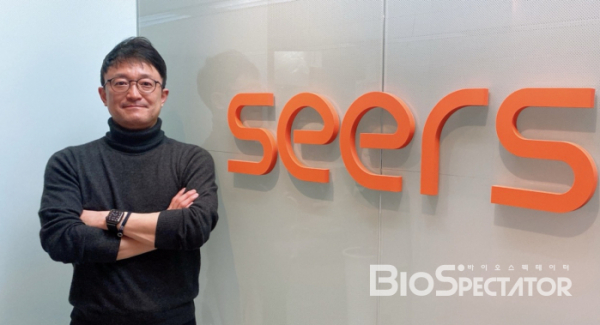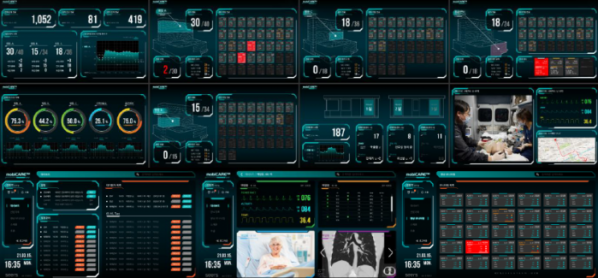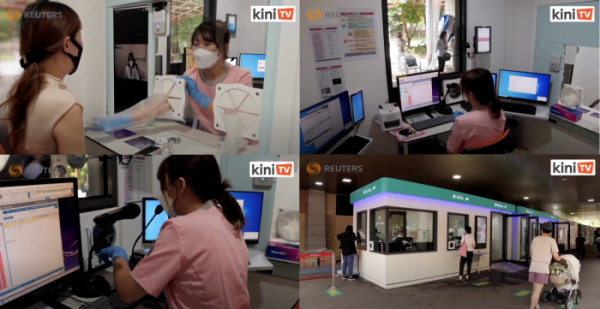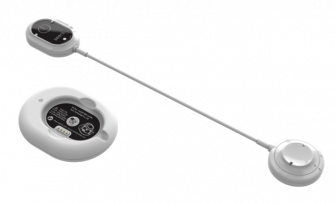기사본문
Seers Technology has the strength in the field of 'Untact Care' based on the 'Wearable'
입력 2022-04-07 14:37 수정 2022-04-07 15:28
by Soyoung Yoon

▲Yeong-shin Lee, CEO of Seers
The field of ‘Digital Care Solution’ is rising in the era of post-pandemic of COVID-19. Unfamiliar to an ordinary people yet, digital care solution stands for the type of digital solutions encompassing H/W and S/W that provide patients with efficient medical care services beyond spatial limitations between doctors and patients. Examples of digital care solutions include untact monitoring solutions enabling doctors to provide patients with real-time care, and telehealth(or telemedicine) solutions for patients who are unable to visit hospitals. Also medical devices for continuous biometric data measurement required for patient monitoring and treatment are included.
Digital care solution is used as a tool for doctors to provide medical care effectively. It cannot substitute for doctors. In this context, it is distinguished from ‘AI (artificial intelligence) Diagnosis’ being developed to replace diagnoses or to minimize interventions made by doctors. Digital solution is founded on the concept of ‘care’ instead of ‘cure’ by which it is also different from ‘Digital Therapeutics (DTx)’ that focuses on an alleviation or cure of symptoms of patients.
Digital solution helps improve the efficiency of a medical system in that it requires no visit of patients to hospitals or face-to-face contacts of doctors with patients. It enables simultaneous care by doctors with diverse information of patients. With the development of digital technology and the situation, wherein the increase in number of doctors cannot keep up with the increase in numbers of beds needed or patients, the digital care emerges as a field of new trend in the medical world.
The field of digital care has been growing continuously before the emergence of pandemic of COVID-19, but the growth is accelerated by the pandemic of COVID-19. In 2020, the Teladoc Health, the telemedicine company in USA, appeared in the market of medical care with an acquisition of Livongo that provides telehealth care solutions for chronic diseases at 18.5 billion USD.
Deals in the field of digital care solutions are continuously made. Last September, Baxter, the leader in the field of medical instrument for dialysis, acquired Hillom, a company developing digital care solutions, at 10.5 billion USD. Hillom provides a variety of digital care solutions such as the platform that helps effective communication between doctors and patients, medical instruments measuring diverse kinds of biosignals, and smart beds. At the time of the acquisition, Joe E. Almeida, the CEO of Baxter, stated, “Patients increasingly want to receive their care at home or nearby, while hospitals and other care providers are increasingly using digital health technologies to expand access, improve quality and lower costs”, and explained that the acquisition of Hillom is part of a strategy of 'Digital Transformation' to provide patients with efficient and personalized solutions.
Further, major healthcare enterprises such as Phillips and GE Healthcare have already made inroads in the existing market of digital care solutions for beds monitoring based on measurements of biodata.
Seers Technology is a company that provides digital care solutions. The strong point of Seers is that it is based on ‘the Wearable’. Seers is currently developing a patient monitoring solution based on biosignals, a kiosk and booth enabling provision of the untact medical care service, and a medical instrument capable of binding with untact solutions and measuring biosignals.
Yeong-shin Lee, CEO of Seers, said, “Our goal is to become a platform operator using wearable medical devices in the long term”, “Seers will provide a smart software bound with artificial intelligence, based on the hardware consisting of wearable instruments for untact healthcare, network, and a booth for providing untact medical care”
Seers was selected for the project of developing an untact medical system of Hallym University Sacred Heart Hospital last year. It then became a supplier of medical care systems for monitoring beds or emergency vehicles, for remote collaborative medical care, for provision of selective care service, and so on. Furthermore, the untact clinic of Seers was selected by the government as a model of system delivering medical care service against infectious disease, such as the pandemic of COVID-19.
Seers also develops a variety of medical devices capable of measuring biosignals such as electrocardiogram, body temperature, oxygen saturation, blood pressure, and blood glucose. Among them, the wearable electrocardiograph and clinical thermometer for body temperature were certified as Class II medical instrument both globally and domestically. The oximeter measuring level of oxygen saturation is currently in progress of a permission by the IRB of Asan Medical Center as well as CE in EU and FDA in USA to attain an approval through conducting clinical trials. The sphygmomanometer of Seers is heading for a release into the market in 2023.
The End-to-End Monitoring Solution using ‘the Wearable’ Device
The patient monitoring solution of Seers is based on biodata of patients measured by the wearable medical instrument. This is the point that differentiates it from Philips and GE Healthcare, which provide existing wired-based bedside monitoring solutions. CEO Lee said, “End-to-end service provision of patient monitoring solutions is only possible when combined with wearable medical devices”
The beds monitoring system of Seers proceeds as follows. First, real-time biodata of patients are collected continuously from medical wearables worn by patients via devices installed in every patient’s room. The collected data is stored on the server in real time, and at the same time, AI algorithms for risk detection work. The patient's biosignal data is recorded and stored, and an alarm signal is sent to the medical staff when a danger is detected according to the alarm settings designated for each patient. With the emergence of alarm, the medical staff will identify patients’ states by video or visual image through an untact system installed in every patient’s room. Through this, the medical staff decides whether it is a situation that requires direct treatment to the patient or not.
With the monitoring solution, medical staff can check the status of multiple patients in real time at the same time without going to the patient's room. This allows the monitoring solution to be used as a tool to increase the work efficiency of the medical staff, freeing from the time and space constraints. In addition, abnormal signals may occur irregularly in continuous bio-signals. In many cases, abnormal signals cannot be caught because it is difficult to measure continuously for several days with the existing bio-signal measurement method. Wearable medical devices can solve these limitations and maximize the effectiveness of monitoring.
If Seers' monitoring solution is applied to an ambulance rather than a hospital bed, it becomes emergency medical monitoring. If a wearable medical device is installed on an emergency patient who arrives in an ambulance, various biosignal data of the emergency patient can be transmitted to the emergency room, and information such as photos, videos, and hospital arrival times can be checked in real time. Through this, hospitals can prepare treatment or surgery in advance to respond more quickly to emergency patients. CEO Lee said, “We are primarily targeting stroke patients, whose the golden time is important.”
Seers is a supplier of the beds monitoring solution to Hallym University Sacred Heart Hospital and Yongin Severance Hospital, which have been appointed Smart Hospitals by the government.

▲Monitoring Solution of Seers Technology: Example of the Display of ‘mobiCARE+Console’
Seers Technology Leads the Era of Untact Medical Care
The initial goal of Seers was to develop telemedicine solution through remote monitoring of patients. Therefore, among Seers' digital care solutions, the first product to be licensed and released was a kiosk, a telehealth platform. Through the kiosk, patients can ask a doctor at home or make an appointment with a doctor, and send messages, photos to a doctor. Video calls are also possible. The kiosks were first serviced in the United States in 2017, and were cumulatively delivered to 10000 households in the United States. Currently, a pilot program is being conducted for the elderly living alone in the UK and Portugal.
Seers has also developed a booth-type telemedicine platform. It is a service enabled to consult via video by installing booths in areas where there is no hospital or where there are no conditions to build a hospital. The service assumes a prearranged “on-call” doctor in charge of remote medical care for patients coming to the booth. The range of treatment that the booth-type telemedicine platform can cover is mild injury, abdominal pain, and re-visit, but it is explained that there is a high demand for such treatment.
CEO Lee stated, “for the case of telehealth platform, it was approved by MFDS in 2011. However, the pilot program has been solely promoted abroad because the domestic promotion of pilot programs was disabled by medical insurance barriers”
However, the government issued guidelines for respiratory clinics due to difficulties in the system of delivering medical care of existing primary, secondary, and tertiary medical institutions in pandemic of COVID-19. In accordance with these guidelines, CEO Lee proposed a model of the booth. In the booth of Seers, patient reception, sample collection, and actual practice of medical care for respiratory symptoms are carried out. Since all processes are non-face-to-face and non-contact, the on-site medical staff do not need to wear Level-D protective clothing, and both the examiner and the patient are provided with a pleasant environment. Doctors can also provide non-face-to-face treatment whenever necessary while watching outpatients in the hospital. Ventilation, negative pressure, heating and cooling in the booth are automatically managed by the monitoring system.
Seers currently verifies the effectiveness of untact booth with Hallym University Sacred Heart Hospital. Besides, the company has been discussing with local governments about the introduction of untact booths. Untact booths will be supplied from the beginning of this year.

▲Untact booth clinic of Seers(Reuter)
The ‘Wearable Medical Instruments’ are the base of Seers
The wearables of Seers measure data of biosignals to be exploited for digital care. “electrocardiogram(ECG), body temperature, oxygen saturation, blood pressure, blood glucose level are regarded as representative biosignals. Currently, Seers is developing medical instruments corresponding to these five biosignals” CEO Lee said, “we are aiming to convert major medical devices needed in a hospital to a wearable medical instrument”
It is easy to understand if you look at the wearable ECG device developed by Seers. Abnormal signals of cardiac disorder are created intermittently. Thus, measurements of ECG over 24 hours are required for the diagnosis of a cardiac disorder. “The standard method currently used for ECG measurement is GE Healthcare’s Holter ECG, which consists of three or more multi-leads,” said CEO Lee. “ since many wires are attached to a body of patients, thereby patients cannot perform their daily activities during the 24-hour period of measuring the ECG”

▲wearable ECG of Seers 'mobiCARE+Cardio'
The wearable ECG of Seers is a single-lead type in which two patches are connected by a single line. Simple shape as it is, patients can manage their daily lives while attaching it to the body. In addition, Seers' ECG can be used conveniently. Furthermore, it solves skin problems attributable to the attachment of patches for long hours. “We have developed a material that does not affect the measurement of biosignals or causing skin troubles” CEO Lee stated, “patients can select either silicone or hydrocolloid of adhesives of the patch according to their skin type. It has passed the human compatibility test and is currently undergoing clinical trials on infants”
Sears also confirmed through clinical trials that Seers' ECG has an accuracy equal to or greater than that of the Holter tester. According to a paper published in 'Sensors' in April, Seers' wearable ECG showed high coincident with Holter in total QRS complexes, ventricular ectopic beats, and supraventricular ectopic beats (ICC 0.991, 1.000, 0.987 respectively). Also, when the expert diagnosed using both measuring instruments, the results were all consistent.
For the aspect of the convenience in use, the wearable ECG of Seers acquired a high score. A total of 82.9% of patients who participated in clinical trials presented opinions of very satisfactory for the ECG of Seers, and 72.3% of patients replied it was better than Holter’s one. From users’ standpoint, it was identified that it was preferred to conventional standard way of measurement.
Then, how about the standpoint of hospitals? CEO Lee explained about Seers' subscription model, saying, "Even if you get a medical device license and apply for medical care benefits as a result of a good clinical trial, whether the hospital uses it is a different story"
In the case of existing ECG devices, hospitals had to purchase ECG devices and analysis software. CEO Lee said, “Existing instruments for electrocardiography and software are highly expensive and the management of instrument and software is troublesome due to damages or caused by disorders arising in the course of measurement”and, “In addition, even if you purchase analytics software, there is a labor cost associated with reviewing the data by a specialist” Due to the cost of purchasing the ECG and analysis software and the cost of hiring a specialist for ECG analysis, the existing ECG measuring equipment is not used in most hospitals.
Seers provides its wearable ECGs to hospitals free of charge. Instead, the ECG analysis service is provided in a subscription form. For the ECG analysis service, you can select an analysis using only AI according to the situation of the hospital, or you can select a model that includes both AI and expert analysis. The subscription service that uses only AI is used when there is an electrocardiogram specialist in the hospital. In the case of AI + expert analysis, it is a service that provides a report by a doctor who has signed a contract with Seers.
Seers has raised accessibility of hospitals by proposing advantages of subscription service, enabling analysis of ECG without initial investment. CEO Lee stated, “the subscription model was adopted by 256 domestic hospitals by last November, by which more than 800 instruments are currently used in each site. Approximately 70% of hospitals adopted the instrument of Seers and subscribing model of ‘AI + Specialist’ for the analysis” He added, “All tertiary hospitals use AI + expert analysis service, because it does not require hiring a specialists”
Last October, the renewal version of the wearable ECG was released after approval was completed. The renewal version equipped with a battery of expanded capacity enables continuous measurement for 7 days without replacement of the battery. Besides, the memory card added additionally advantages of storing data of ECG measurements, thereby enabling measurement of sensor alone without interlocking with smartphone. Consequently, the accessibility of patients who feel difficulties in using smartphones was improved. He also extended the frequency response characteristics of sensor of the instrument to the range 0.05~55 Hz (mostly, signals in the bandwidth 0.67~40 Hz are detected), thereby enabling the detection of more symptoms of arrhythmia such as ST segment and so on.

▲Patch type thermometer of Seers 'mobiCARE+Temp'
The Potential of Market Expansion through Exploitation of Various Wearable Medical Instruments
Besides wearable ECG, Seers also develops other kinds of wearable medical instruments such as patch-type/non-contact thermometers and watch-type oxygen saturation devices. In addition, the company tries to expand the scope of application of medical instruments by combining these instruments. CEO Lee said, “The biggest challenge for wearable medical devices is how to expand the market. Rather than using the ECG analysis device only for ECG analysis, we need to expand the medical field so that it can be used in various fields, so we are conducting various clinical trials.”
There are diverse fields for the application of ECG. Seers Technology currently proceeds clinical trials with the wearable ECG in the departments of mental health medicine and obstetrics & gynecology beyond existing departments of cardiology and cardiovascular diseases. CEO Lee stated, “The balance in automatic nerves can be predicted by analyzing varied cardiac rhythms through the ECG patch. We proceed clinical trials with the patch for monitoring mental health and developing relevant services”and, “Currently, clinical trials in the field of mental health are based on surveys, so there are many subjective factors. The introduction of a wearable ECG helps doctors make decisions because objective information can be obtained.” Seers is currently conducting clinical trials for the elderly with Minds AI and Gangnam Severance, and has completed the recruitment of more than 100 subjects.
As for the clinical trial in the department of obstetrics & gynecology, it is proceeded in the Gangnam Severance Hospital with infertility patients. It was explained that varied cardiac rhythms could be detected through the patch of ECG, while the varying body temperature, detected through the patch of clinical thermometer, could be analyzed to identify changes in the secretion of LH(luteinizing hormone) known to induce ovulation. It has the advantage of being able to monitor changes in hormones in real time without drawing blood.







